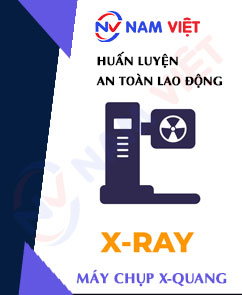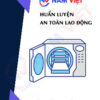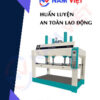Occupational Safety Training for Operating X-Ray Machines
99,000 ₫
Note: The above price is calculated per person and may vary depending on the number of trainees participating in the course and market fluctuations. For more accurate pricing support, please refer to the pricing list or contact our consulting staff directly.
Occupational safety is an important issue when operating the x-ray machine and needs to be addressed promptly to ensure the health and safety of workers and enhance the reputation of businesses here. The Occupational Safety Training is one of the effective solutions to raise awareness on how to prevent occupational accidents for workers operating the x-ray machine.
Table of Contents
Toggle1. Overview of X-ray Machine
a. What is an X-ray Machine?
An X-ray machine is a medical device used to create images of the body using X-rays. It is widely used in the medical field for diagnosing and treating various health issues.
X-ray machines can capture images of many parts of the body, including bones, lungs, heart, stomach, intestines, and other organs. X-ray images provide valuable information for doctors and healthcare professionals to make accurate diagnoses and treatment plans.
Although X-ray use brings significant benefits in medicine, safety measures must be observed to protect patients and medical staff from X-ray side effects, including minimizing radiation exposure and using appropriate protective equipment.

b. How an X-ray Machine Works
The operation of an X-ray machine is based on the interaction between X-rays and body structures, and the process of capturing images as X-rays pass through tissues and organs. The following describes the working principle in detail:
- X-ray Source: The X-ray machine has an X-ray tube, usually a vacuum tube, powered to generate X-rays. Inside this tube, a cathode and an anode create an electric current. Electrons from the cathode accelerate towards the anode at high speed, producing X-rays when striking a target material.
- X-rays: The X-rays generated are a form of high-energy electromagnetic radiation. They travel straight and quickly through space and the body.
- Interaction with the Body: As X-rays pass through the body, they are absorbed or scattered by various structures like bones, soft tissue, and organs. This absorption or scattering creates differences in the X-rays reaching the detector.
- Image Detection: An X-ray detector behind the body records the X-rays that pass through, creating a 2D image of internal structures. The computer generates the image based on the level of absorption or scattering of different tissues.
- Image Display: The image is then displayed on a screen or printed on film for medical diagnosis.

c. Industries Using X-ray Machines
X-ray machines are widely used across different sectors, primarily in medicine. Key industries include:
- Healthcare and Hospitals: The main field for X-ray use. Doctors, medical specialists, and X-ray technicians use machines to diagnose and treat health issues, including checking bones, detecting injuries, identifying diseases, and monitoring progress.
- Dentistry: Used to capture images of teeth and gums to help dentists diagnose oral health issues and measure tooth pulp length.
- Medical Imaging: Often part of more complex imaging systems like MRI and CT. X-rays provide fast, cost-effective imaging suitable for various applications.
- Sports Medicine: Used to diagnose sports injuries, especially bone and surrounding tissue damage after collisions or trauma.
- Veterinary Medicine: Used to diagnose and treat animal health issues, including fractures and internal organ problems.
- Industry and Security: Beyond medicine, X-ray machines inspect goods, ensure security, control product quality, and detect hazardous materials.

2. Overview of Occupational Safety Training for Operating X-ray Machines
a. What is Occupational Safety Training?
- Occupational safety training for operating X-ray machines involves courses that raise awareness on preventing workplace accidents. Employees who directly operate X-ray machines fall under Group 3.
- Safety training helps workers recognize hazards and prevent risks, reducing workplace accidents while operating machines.
REGISTER FOR OCCUPATIONAL SAFETY TRAINING
b. Training Duration
Initial safety training duration:
- Total training hours must be at least 24 hours, including exams.
- 8 hours of theory on safety policies and labor hygiene laws
- 8 hours of theory on basic occupational safety knowledge
- 4 hours of theory on specialized training content
- 2 hours of practical training on specialized content
- 2 hours of final theory exam
The training center will schedule sessions depending on employees’ availability, usually in 6 sessions over 3 days, if the company can provide continuous learning time.
Periodic safety training:
- Before the occupational safety card expires, employees must attend a periodic safety training course, with a duration at least 50% of the initial training time.
Explanation: Total periodic training time is at least 12 hours, including the exam. After completing the course and passing the test, employees will have their safety card renewed.
c. Training Content
| No. | TRAINING CONTENT | TRAINING DURATION (HOURS) | |||
| Total | Breakdown | ||||
| Theory | Practical | Exam | |||
| I | Safety Policies and Labor Hygiene Laws | 8 | 8 | 0 | 0 |
| 1 | Overview of safety regulations and legal documents. | 6 | 6 | ||
| 2 | Standards and technical regulations for occupational safety and hygiene. | 1 | 1 | ||
| 3 | Specific regulations from state management agencies for construction, expansion, or renovation of facilities; use and inspection of machines, equipment, materials with strict safety requirements. | 1 | 1 | ||
| II | Basic Knowledge of Occupational Safety | 8 | 8 | 0 | 0 |
| 1 | Basic knowledge of workplace hazards and harmful factors. | 4 | 4 | ||
| 2 | Methods to improve working conditions. | 1 | 1 | ||
| 3 | Safety culture in production and business. | 1 | 1 | ||
| 4 | Rights and responsibilities of employers and employees; policies on occupational safety; roles of safety officers. | 1 | 1 | ||
| 5 | Workplace safety rules, signage, use of safety equipment and personal protective equipment; first aid skills; occupational disease prevention. | 1 | 1 | ||
| III | Specialized Training Content | 6 | 4 | 2 | 0 |
| Comprehensive knowledge of machines, equipment, hazardous substances; risk assessment and management; safe work procedures for equipment and materials with strict safety requirements. | 6 | 4 | 2 | ||
| IV | Final Safety Training Exam | 2 | 2 | 0 | 0 |
| Total | 24 | 22 | 2 | ||
See more training content for all 6 groups
d. Occupational Safety Card
After completing safety training and passing the exam, employees will receive a Group 3 Occupational Safety Card (commonly called Occupational Safety Certificate for Group 3).
The card shows details like full name, date of birth, job, and work environment. It also includes training duration, an official stamp, and signature confirming course completion.
According to regulations in Clause 2, Article 24 of Decree 44/2016/ND-CP, there are two cases:
- If the employer and employee have a labor contract, the employer must sign, stamp, and validate the Group 3 safety card after the employee completes training and passes the exam.
- If the worker is freelance or temporary, without a labor contract, the training center must sign, stamp, and validate the safety card after the employee completes training and passes the exam.

3. Hazards for Workers Operating X-ray Machines
Operating X-ray machines can pose hazards to workers if safety measures are not followed and attention is not carefully maintained. Below are some common hazards that may occur when operating X-ray machines:
- Ionizing radiation: X-rays are a form of ionizing radiation, which can cause unwanted effects on exposed individuals if proper protection is not used. Workers may face the risk of radiation burns if exposed directly or improperly protected in the workplace.
- Long-term effects of radiation: Repeated exposure to X-rays can lead to long-term adverse effects, including an increased risk of cancer and other health problems.
- Electromagnetic exposure: X-ray machines can generate strong electromagnetic fields, posing risks of electric shock or other health issues if not properly shielded or isolated.
- Mechanical hazards: Mechanical components of X-ray machines can cause injury or trauma if workers do not follow safety procedures when working near the machine or during maintenance.
- Chemical hazards: Some chemicals and materials used in the production and maintenance of X-ray machines can be toxic if not handled correctly or safely.
To minimize these hazards, it is necessary to establish and adhere to safety measures and manufacturer operating instructions, as well as provide comprehensive training for workers on the safe and effective use of X-ray machines. Regular monitoring and inspections are also an important part of maintaining a safe working environment when using X-ray machines.
4. Measures to Control Workplace Accidents When Operating X-ray Machines
To control workplace accidents when operating X-ray machines, appropriate safety measures should be implemented. Below are some necessary control measures:
- Training and education: Ensure that all staff are fully trained in safety when operating and working near X-ray machines. Training should include safety procedures, preventive measures, and guidance on the use of protective equipment.
- Use of protective equipment: Ensure that all staff operating X-ray machines are provided with and properly use protective gear such as safety goggles, protective clothing, radiation-resistant gloves, and masks.
- Exposure time control: Limit the time staff are exposed to X-rays by reducing time spent near the machine and ensuring that work procedures are performed quickly and efficiently.
- Safe exposure techniques: Implement technical measures to reduce direct exposure to X-rays, including using shielding equipment and ensuring staff do not stand near the machine while it is operating.
- Regular inspection and maintenance: Conduct regular inspections and maintenance of X-ray machines to ensure efficient and safe operation. Routine maintenance also helps detect technical issues early and reduce the risk of accidents.
- Follow safety procedures: Comply with safety procedures established by manufacturers and regulatory authorities to ensure safe and effective operation of X-ray machines.
- Periodic inspection of X-ray machines to detect safety issues such as wear, mechanical failure, or malfunction early, thereby reducing the risk of workplace accidents.

5. Benefits of Occupational Safety Training
An Toàn Nam Việt provides your business with the following benefits upon completing occupational safety training courses as regulated under Decree 44/2016/ND – CP regarding occupational health and safety for companies, factories, and enterprises.
- Workers can identify potential occupational hazards and take preventive measures to avoid accidents.
- Your business can establish risk prevention measures in production, operation, and maintenance processes.
- Minimize costs associated with safety incidents.
- Uninterrupted production increases labor productivity and product quality.
- Compliance with occupational safety laws reduces legal risks.
- Enhances reputation and professionalism, strengthening your brand.
Nam Việt’s training courses help prevent external hazards from affecting individuals, allowing them to avoid injuries or, in severe cases, fatalities.
REGISTER FOR OCCUPATIONAL SAFETY TRAINING SERVICES
6. Customer Feedback After Completing the Training
An Toàn Nam Việt has years of experience supporting businesses across Vietnam, particularly in southern provinces. This responsibility is highly valued, which is why Nam Việt’s occupational safety training is increasingly professional. The growth of Nam Việt is driven by positive feedback and suggestions from partner businesses. Below are testimonials from clients we have served.
See more customer interviews after using An Toàn Nam Việt’s services
7. An Toàn Nam Việt’s Occupational Safety Training Capabilities
An Toàn Nam Việt is a reputable and high-quality occupational safety training center in Vietnam. Training sessions are conducted continuously at factories, workshops, and construction sites across the country (all 63 provinces).
REGISTER FOR OCCUPATIONAL SAFETY TRAINING SERVICES
Occupational Safety Training License
- An Toàn Nam Việt has been inspected and certified by the Department of Safety under the Ministry of Labor – Invalids and Social Affairs for eligibility to conduct occupational safety and hygiene training. This further strengthens our training capacity.

Training Materials and Lectures
- Before being used in OST courses, materials are reviewed to ensure accuracy and effectiveness.
- Teaching methods are standardized according to An Toàn Nam Việt standards, developed by occupational safety experts to maximize learning outcomes.
Facilities
- Controlling classroom factors improves teaching efficiency and knowledge retention.
- Our training facilities provide spacious classrooms with standard lighting, training equipment, and more.
8. Nationwide Reputable Occupational Safety Training Center
At An Toàn Nam Việt, we prioritize occupational safety training as a top professional commitment. Teaching workers to protect themselves contributes to nation-building.
We meticulously prepare every detail for effective training—from tools and teaching equipment to curricula, documents, audio, and lighting.
Our trainers are experienced experts, with research on hazard identification across industries and prevention methods.
Lectures are practical, engaging, and easy to understand, ensuring workers are comfortable and learn effectively. Training strictly follows Decree 44/2016/ND-CP.
Workers learn preventive measures and self-protection techniques applicable to real work situations.
Our training center is proud to provide professional occupational safety training with the following advantages:
- Competitive training costs with guaranteed quality.
- Flexible training schedules aligned with company operations.
- Fast and compliant certification procedures.
- Experienced professional trainers.
- Controlled classrooms enhance teaching efficiency and knowledge retention.
- Lessons tailored for occupational safety in enterprises.
- Dedicated and professional support for customers promptly and accurately.

9. Additional Occupational Safety Training Materials
- Occupational Safety Training Materials
- Occupational Safety Materials for Operating X-ray Machines
- Occupational Safety Training Test Collection
- Multiple-choice Test for X-ray Machine Safety
- Slides for Occupational Safety Training for X-ray Machine Operation
1 review for Occupational Safety Training for Operating X-Ray Machines
No comments yet















phanminhhang341
Giảng viên dạy rất sinh động dễ hiểu!